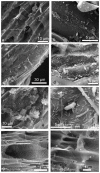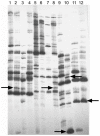Primary metabolism of chickpea is the initial target of wound inducing early sensed Fusarium oxysporum f. sp. ciceri race I
- PMID: 20140256
- PMCID: PMC2815786
- DOI: 10.1371/journal.pone.0009030
Primary metabolism of chickpea is the initial target of wound inducing early sensed Fusarium oxysporum f. sp. ciceri race I
Abstract
Background: Biotrophic interaction between host and pathogen induces generation of reactive oxygen species that leads to programmed cell death of the host tissue specifically encompassing the site of infection conferring resistance to the host. However, in the present study, biotrophic relationship between Fusarium oxysporum and chickpea provided some novel insights into the classical concepts of defense signaling and disease perception where ROS (reactive oxygen species) generation followed by hypersensitive responses determined the magnitude of susceptibility or resistant potentiality of the host.
Methodology/principal findings: Microscopic observations detected wound mediated in planta pathogenic establishment and its gradual progression within the host vascular tissue. cDNA-AFLP showed differential expression of many defense responsive elements. Real time expression profiling also validated the early recognition of the wound inducing pathogen by the host. The interplay between fungus and host activated changes in primary metabolism, which generated defense signals in the form of sugar molecules for combating pathogenic encounter.
Conclusions/significance: The present study showed the limitations of hypersensitive response mediated resistance, especially when foreign encounters involved the food production as well as the translocation machinery of the host. It was also predicted from the obtained results that hypersensitivity and active species generation failed to impart host defense in compatible interaction between chickpea and Fusarium. On the contrary, the defense related gene(s) played a critical role in conferring natural resistance to the resistant host. Thus, this study suggests that natural selection is the decisive factor for selecting and segregating out the suitable type of defense mechanism to be undertaken by the host without disturbing its normal metabolism, which could deviate from the known classical defense mechanisms.
Conflict of interest statement
Figures









Similar articles
-
Analysis of root proteome unravels differential molecular responses during compatible and incompatible interaction between chickpea (Cicer arietinum L.) and Fusarium oxysporum f. sp. ciceri Race1 (Foc1).BMC Genomics. 2014 Nov 3;15(1):949. doi: 10.1186/1471-2164-15-949. BMC Genomics. 2014. PMID: 25363865 Free PMC article.
-
A molecular insight into the early events of chickpea (Cicer arietinum) and Fusarium oxysporum f. sp. ciceri (race 1) interaction through cDNA-AFLP analysis.Phytopathology. 2009 Nov;99(11):1245-57. doi: 10.1094/PHYTO-99-11-1245. Phytopathology. 2009. PMID: 19821728
-
Fusarium oxysporum f.sp. ciceri race 1 induced redox state alterations are coupled to downstream defense signaling in root tissues of chickpea (Cicer arietinum L.).PLoS One. 2013 Sep 13;8(9):e73163. doi: 10.1371/journal.pone.0073163. eCollection 2013. PLoS One. 2013. PMID: 24058463 Free PMC article.
-
In search of decoy/guardee to R genes: deciphering the role of sugars in defense against Fusarium wilt in chickpea.Plant Signal Behav. 2010 Sep;5(9):1081-7. doi: 10.4161/psb.5.9.12234. Epub 2010 Sep 1. Plant Signal Behav. 2010. PMID: 20855953 Free PMC article. Review.
-
The Fusarium oxysporum f. sp. ciceris/Cicer arietinum pathosystem: a case study of the evolution of plant-pathogenic fungi into races and pathotypes.Int Microbiol. 2004 Jun;7(2):95-104. Int Microbiol. 2004. PMID: 15248157 Review.
Cited by
-
Integrative network analyses of wilt transcriptome in chickpea reveal genotype dependent regulatory hubs in immunity and susceptibility.Sci Rep. 2018 Apr 25;8(1):6528. doi: 10.1038/s41598-018-19919-5. Sci Rep. 2018. PMID: 29695764 Free PMC article.
-
Defence response in plants and animals against a common fungal pathogen, Fusarium oxysporum.Curr Res Microb Sci. 2022 Apr 19;3:100135. doi: 10.1016/j.crmicr.2022.100135. eCollection 2022. Curr Res Microb Sci. 2022. PMID: 35909626 Free PMC article. Review.
-
Combined De Novo Transcriptome and Metabolome Analysis of Common Bean Response to Fusarium oxysporum f. sp. phaseoli Infection.Int J Mol Sci. 2019 Dec 12;20(24):6278. doi: 10.3390/ijms20246278. Int J Mol Sci. 2019. PMID: 31842411 Free PMC article.
-
Fusarium oxysporum mediates systems metabolic reprogramming of chickpea roots as revealed by a combination of proteomics and metabolomics.Plant Biotechnol J. 2016 Jul;14(7):1589-603. doi: 10.1111/pbi.12522. Epub 2016 Jan 23. Plant Biotechnol J. 2016. PMID: 26801007 Free PMC article.
-
Perception of Damaged Self in Plants.Plant Physiol. 2020 Apr;182(4):1545-1565. doi: 10.1104/pp.19.01242. Epub 2020 Jan 6. Plant Physiol. 2020. PMID: 31907298 Free PMC article. Review.
References
-
- Dixon RA, Harrison MJ, Lamb CJ. Early events in the activation of plant defense responses. Ann Rev Phytopathol. 1994;32:479–501.
-
- Glazebrook J. Contrasting mechanism of defense against biotrophic and necrotrophic pathogens. Ann Rev Phytopathol. 2005;43:205–227. - PubMed
-
- Doehlemann G, Ramon W, Horst RJ, Voll LM, Usadel B, et al. Reprogramming a maize plant: transcriptional and metabolic changes induced by the fungal biotroph Ustilago maydis. Plant J. 2008;56:181–195. - PubMed
-
- Mendgen K, Hahn M. Plant infection and the establishment of fungal biotrophy. Trends Plant Sci. 2002;7:352–356. - PubMed
Publication types
MeSH terms
Substances
LinkOut - more resources
Full Text Sources

